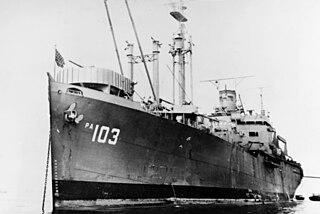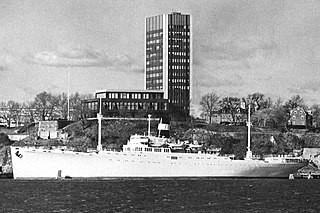
An ocean liner is a type of passenger ship primarily used for transportation across seas or oceans. Ocean liners may also carry cargo or mail, and may sometimes be used for other purposes. Only one ocean liner remains in service today.
The 4 Aces were the quartet of passenger-cargo liners Excalibur, Exochorda, Exeter, and Excambion, originally built for American Export Lines by New York Shipbuilding of Camden, New Jersey between 1929 and 1931. AEL placed the "4 Aces" in service between the US and the Mediterranean, offering cruises of up to 40 days.

A bridge, also known as a pilothouse or wheelhouse, is a room or platform of a ship from which the ship can be commanded. When a ship is under way, the bridge is manned by an officer of the watch aided usually by an able seaman acting as a lookout. During critical maneuvers the captain will be on the bridge, often supported by an officer of the watch, an able seaman on the wheel and sometimes a pilot, if required.

SS Schiller was a 3,421-ton German ocean liner, one of the largest vessels of her time. Launched in 1873, she plied her trade across the Atlantic Ocean, carrying passengers between New York City and Hamburg for the German Transatlantic Steam Navigation Line. She became notorious on 7 May 1875, while operating on her normal route, when she hit the Retarrier Ledges in the Isles of Scilly, causing her to sink with the loss of most of her crew and passengers, totaling 335 fatalities.
SS V.A. Fogg was a modified T2 tanker built in 1943, as SS Four Lakes. After service in World War II, she was eventually sold into private ownership. She was renamed V.A. Fogg in 1971, shortly before she exploded and sank off Freeport, Texas.

USS Queens (APA-103) was a Windsor-class attack transport that served with the US Navy during World War II. She was commissioned late in the war and initially assigned to transport duties; consequently she did not take part in any combat operations.

The Windsor-class attack transport was a class of nine US Navy attack transports. Ships of the class saw service in World War II.

USS Crescent City (AP-40/APA-21) was the lead ship of the Crescent City-class attack transports that served with the US Navy during World War II. The ship was built as the cargo and passenger liner Delorleans for the Mississippi Shipping Company's Delta Line. After brief commercial operation the ship was among 28 vessels requisitioned in June 1941 for the Navy and the Army. The Navy renamed the ship Crescent City, a popular nickname for New Orleans, Louisiana, upon commissioning 10 October 1941. The ship was decommissioned and laid up in 1948 before being loaned to the California Maritime Academy to serve as a training ship 1971–1995 and then transferred to a foundation in a failed art colony project. The ship left California for Texas scrapping in 2012.

RMS Empress of China was an ocean liner built in 1890-1891 by Naval Construction & Armament Co., Barrow, England for Canadian Pacific Steamships (CP). This ship—the first of three CP vessels to be named Empress of China—regularly traversed the trans-Pacific route between the west coast of Canada and the Far East until she struck an underwater reef and sank in Tokyo harbour in 1911.

RMS Empress of Scotland, originally SS Kaiserin Auguste Victoria, was an ocean liner built in 1905–1906 by Vulcan AG shipyard in Stettin for the Hamburg America Line. The ship regularly sailed between Hamburg and New York City until the outbreak of war in Europe in 1914. At the end of hostilities, re-flagged as USS Kaiserin Auguste Victoria, she transported American troops from Europe to the United States. For a brief time Cunard sailed the re-flagged ship between Liverpool and New York.

SS Prinz Friedrich Wilhelm was an ocean liner for North German Lloyd (NDL) from her launch in 1907 until the end of World War I. After the war, she briefly served as USS Prinz Friedrich Wilhelm (ID-4063) for the United States Navy returning American troops from France. The vessel was first chartered—and later purchased outright—by Canadian Pacific Steamships (CP) and operated under the names Empress of China, Empress of India, Montlaurier, Monteith, and Montnairn. She was scrapped in 1929.

SS Stevens, a 473-foot (144 m), 14,893-ton ship, served as a floating dormitory from 1968 to 1975 for about 150 students of Stevens Institute of Technology, a technological university, in Hoboken, New Jersey. Permanently moored on the scenic Hudson River at the foot of the campus across from New York City, this first collegiate floating dormitory became one of the best-known college landmarks in the country.

SS Exochorda was a 473-foot, 14,500-ton cargo liner in service with American Export Lines from 1948 to 1959. A member of the line's post-war quartet of ships, "4 Aces", Exochorda sailed regularly from New York on a Mediterranean route. Originally built in 1944 as the military attack transport USS Dauphin (APA-97), the ship was extensively refurbished prior to her service as a passenger-cargo liner. Following her service as a cruise liner, the vessel served as the floating dormitory ship SS Stevens for the students of Stevens Institute of Technology, a technological university, in Hoboken, NJ. At the end of her service life she was scrapped, in 1979.
Shark River Reef is an artificial reef located in the Atlantic Ocean, 15.6 miles southeast of Manasquan Inlet, off of the coast of Ocean County, New Jersey. The site contains almost 4 million cubic yards of dredge rock material. Although 96% of the total reef material is rock, the site also contains numerous subway cars.
The following index is provided as an overview of and topical guide to Wikipedia's articles on recreational dive sites. The level of coverage may vary:

Recreational dive sites are specific places that recreational scuba divers go to enjoy the underwater environment or for training purposes. They include technical diving sites beyond the range generally accepted for recreational diving. In this context all diving done for recreational purposes is included. Professional diving tends to be done where the job is, and with the exception of diver training and leading groups of recreational divers, does not generally occur at specific sites chosen for their easy access, pleasant conditions or interesting features.

The James River Reserve Fleet (JRRF) is located on the James River in the U.S. state of Virginia at near Fort Eustis. James River Reserve Fleet, a "ghost fleet", is part of the National Defense Reserve Fleet. The Reserve Fleet ships in storage, called "mothballed", that can be ready for use if needed. Many are awaiting scrapping due to the age or condition of the ship. Some ships are used for target practice or as artificial reefs. A few ships became museum ships and other sold to private companies. Ships can be readied for use in 20 to 120 days during national emergencies or natural disaster. The U.S. Department of Transportation's Maritime Administration (MARAD) provides oversight of the James River Reserve Fleet. For the United States Navy ships the United States Navy reserve fleets stored these ships and submarines.














